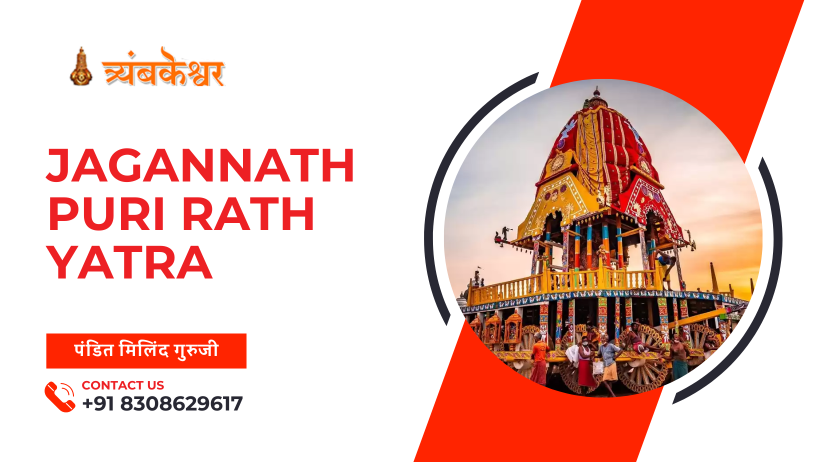
- January 1, 2025
- Pandit Milind Guruji
- 0
Jagannath Puri Rath Yatra 2025: A Spiritual Journey of Devotion
The Jagannath Puri Rath Yatra, also known as the Festival of Chariots, is one of the most revered and grandest religious festivals in India. Celebrated annually in the sacred city of Puri, Odisha, this vibrant event attracts millions of devotees from across the globe. In 2025, the Rath Yatra will commence on Friday, June 27, marking a significant occasion for spiritual seekers and cultural enthusiasts alike.
📜 Historical Background of Rath Yatra
The origins of the Rath Yatra trace back to ancient times, with references found in sacred texts like the Brahma Purana, Padma Purana, and Skanda Purana. The festival symbolizes Lord Jagannath’s annual journey to his aunt’s temple, the Gundicha Temple, accompanied by his siblings, Lord Balabhadra and Devi Subhadra. This journey represents the deities’ desire to be among their devotees, breaking the barriers of the temple sanctum and embracing all, irrespective of caste, creed, or religion.
🗓️ Rath Yatra 2025: Dates and Timings
Main Rath Yatra Day: Friday, June 27, 2025
Dwitiya Tithi Begins: 1:24 PM on June 26, 2025
Dwitiya Tithi Ends: 11:19 AM on June 27, 2025
The festival spans over nine days, culminating with the Bahuda Yatra (return journey) and the Suna Besha (golden attire) ceremony.
🛕 The Deities and Their Chariots
During the Rath Yatra, the three principal deities are placed on grand chariots and pulled through the streets by devotees.
1. Lord Jagannath’s Chariot – Nandighosa
Height: 45 feet
Wheels: 16
Color: Red and Yellow
Flag: Garuda
2. Lord Balabhadra’s Chariot – Taladhwaja
Height: 44 feet
Wheels: 14
Color: Red and Blue
Flag: Unnani
3. Devi Subhadra’s Chariot – Darpadalana
Height: 43 feet
Wheels: 12
Color: Red and Black
Flag: Nadambika
These chariots are constructed anew each year, adhering to traditional specifications and rituals.
🎉 Rituals and Celebrations
1. Snana Purnima
Before the Rath Yatra, on the full moon day of the Hindu month of Jyeshtha, the deities are bathed with 108 pots of sacred water in a ritual known as Snana Purnima. Post this ceremony, the deities are believed to fall ill and are kept away from public view, a period called Anavasara.
2. Netrotsava
After the Anavasara period, the deities are given new eyes in a ritual called Netrotsava, symbolizing their recovery and readiness for the Rath Yatra.
3. Pahandi Bije
On the day of the Rath Yatra, the deities are brought out of the temple in a grand procession known as Pahandi Bije, where they are carried to their respective chariots amidst chants and music.
4. Chhera Pahara
Before the chariots commence their journey, the Gajapati King of Puri performs the Chhera Pahara ritual, where he sweeps the chariot platforms with a golden broom, signifying that everyone is equal in the eyes of the Lord.
5. Gundicha Temple Stay
The deities stay at the Gundicha Temple for seven days, after which they return to the main temple in a return journey called Bahuda Yatra.
6. Suna Besha
On the day after the Bahuda Yatra, the deities are adorned with gold ornaments in a ceremony known as Suna Besha, attracting a massive gathering of devotees.
🌍 Cultural and Spiritual Significance
The Rath Yatra transcends religious boundaries, welcoming people from all walks of life to witness and participate in the divine procession. It symbolizes the Lord’s journey among his devotees, emphasizing humility, equality, and the universal nature of divinity.
❓ Frequently Asked Questions (FAQs)
Q1: Can non-Hindus participate in the Rath Yatra?
A: Yes, the Rath Yatra is open to all, regardless of religion or background. The deities come out of the temple to bless all devotees.
Q2: What is the significance of pulling the chariots?
A: Pulling the chariots is considered a pious act, believed to cleanse sins and grant spiritual merit.
Q3: Why are new chariots built every year?
A: Building new chariots annually signifies renewal and adherence to tradition, ensuring the sanctity of the festival.
Q4: What is the best time to visit Puri for the Rath Yatra?
A: Visiting Puri a few days before the Rath Yatra allows one to witness the preparations and participate in the full spectrum of rituals.
🧭 Travel Tips for Devotees
Accommodation: Book hotels or guesthouses well in advance due to the influx of pilgrims.
Transportation: Plan your travel early; special trains and buses are often arranged for the festival.
Health Precautions: Stay hydrated and be prepared for large crowds and long walks.
Local Etiquette: Respect local customs and participate in rituals with reverence.
📝 Conclusion
The Jagannath Puri Rath Yatra is not merely a festival; it’s a profound spiritual journey that embodies devotion, unity, and the timeless traditions of India. Participating in this grand event offers an unparalleled experience of faith and cultural richness.
